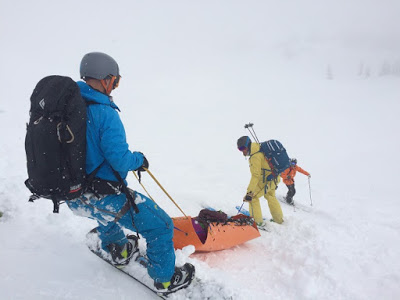
|
| Sked training Photo: Alexa Hohenberg |
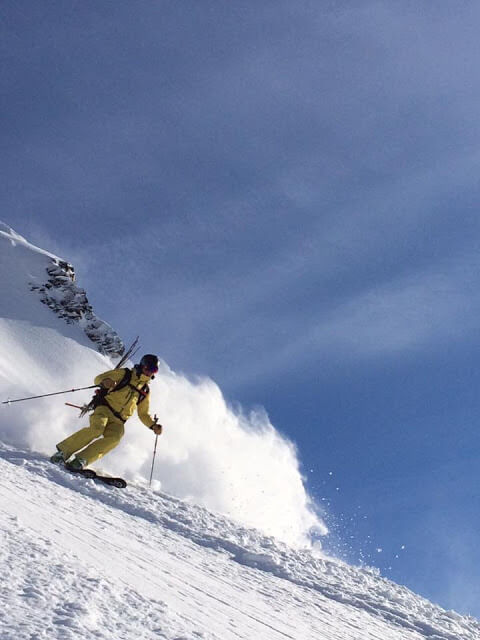
|
|
"Land and Slay"
Photo: Alexa Hohenberg |
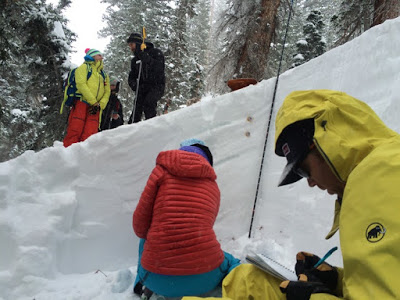
|
||
|
Looking for
persistent
weak layers in the Wasatch
Photo: Alexa Hohenberg
|
By that point I had completed the AMGA Ski Guide
Course, my Level I, II and III AIARE Avalanche Education courses, and that is when
Alaska beckoned. Once again too poor to
do a full heli week, 3 friends and I rented an RV and chased the best snow we
could find in Turnagain Pass, Hatcher Pass and Thompson Pass on the ultimate
ski mountaineering adventure. After
nearly a week of being buzzed by helicopters we finally broke down and visited Alaska
Rendezvous for a one bump to ski a few lines deeper in the zone. They were the best runs of the trip, and at
the end I approached the late owner Theo Meiners, and asked how to apply and he
simple stated, “You don’t, around here we use guide applications as toilet
paper!” He was joking of course, kind of, but truth be told breaking into the
heli skiing world takes a tremendous about of luck, timing and is often about connections.
|
|
| Life is good, waiting for the heli. The world famous Lel Tone, myself, Matt Ward, & Alexa Hohenberg Photo: Keith Davis |
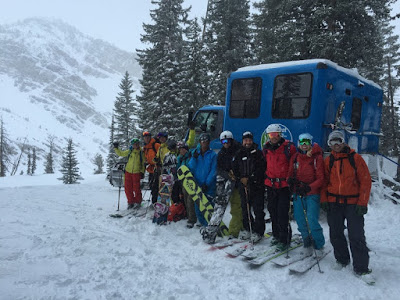
|
| Snowbird Cat Skiing and the whole Heli Ski US crew |
I was on a well-defined path
towards the IFMGA, but as a student I always look for opportunities to better
myself as a guide. After completing my
AMGA Ski and Rock Guide Certifications, and getting beat up a little on my
Alpine exam, I decided I needed a palate cleanser and to chase a dream. After some quick internet research and an email to Kevin Quinn, president of Heli Ski US Association and Owner of
Points North Heli, I decided it was time to explore this niche of the guiding
world. The AMGA has been great, and over the course of my certification we did
get to use helicopters and snow cats; however, we were treated far more like
clients when working around the machines and I wanted that coveted front seat.
The AMGA is still the top echelon of guide training and they are phenomenal
about teaching the nuances of up and downhill guiding, avalanche forecasting
and hazard evaluation, client care and guide security, but at least in my
training, they are not teaching directly to the mechanized guiding world.
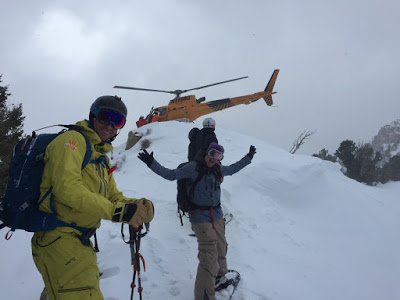
|
|
Gear
I could not live without: Alyeska GTX Pro Jacket, Alyeska Realization
harness pants and my RAS and PAS Airbag Systems, they were
literally
made for heli skiing!
Wasatch LZ- Photo: Lel Tone |
“In the early 1980’s a group of US Heli Ski operators started meeting annually on a very informal basis. The purpose of these meetings was to exchange various ideas, thoughts and information that would help each operator. At this time there were no standards for operation. It was through these meetings that the Heli-Ski US Association was eventually formalized as a 501C corporation and thus began a more formal approach to the development of standards and protocols for helicopter skiing activities within the US. Many of the standards were already in place from the reputable Canadian operators and now HSUS is also an affiliate member of HeliCat Canada sharing many of the very same standards."
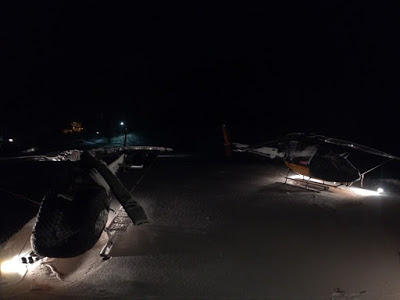
|
| Wasatch Powderbird Guides home base pre-dawn "time to make the forecast" |
In addition to these meetings they created Heli Ski
US Guide School. This, I believe, was only
its second year offering the school, but it caters directly to those interested
in gaining knowledge of the mechanized world.
I would not say they are competing with the AMGA but supplementing a
needed niche. Currently the application
standards are very attainable, and while I may have had the most experience on paper,
the other participants outnumbered me on heli days almost 10:1. They all had
been heli skiing for years and their confidence in and around the helicopter showed;
where I admit I was far more confident once the heli left us at the top and all
we had to do was ski some the coolest deepest runs of my life.
|
|
|
Loading the PZ
Photo Lel Tone |
The Guide School is broken down into two one-week
sessions. This year the first session
was held in Utah at Wasatch Powderbird Guides to get us working in a
continental snowpack, and the second session was held at Points North Heli in
Cordova, Alaska to poke around in a more maritime snowpack. In reality the snow pack differences played
second fiddle to the real reason: to introduce us to these two amazing yet
different operations and get tied into the community of idols and mentors in
each region.
|
|
|
Land, Assess, Open and Slay "
Ridiculous"
Photo Lel Tone |
Wasatch Powderbird Guides is based right in the
middle of Little Cottonwood Canyon and mostly caters to day guests and private
charters. This was my first introduction to just how welcoming these operations
would be. They lifted the
skirt of every aspect of their operation, welcoming us to be a part of everything
from guide meetings, avalanche forecasting, rescue training and treated us like
staff. This full immersion is great, but the greatest strength of the Heli Ski US program is the industry giants they
bring in. Lel Tone, over the two
weeks, was in charge of herding us like stray cats and just happens to be ski
patrol extraordinaire, reality TV star (she’ll kill me for mentioning that) but
most importantly heli skiing royalty. Joe Royer
from Ruby Mountain Heli, who has run the country’s oldest heli ski operation in
the United States, was our second instructor and general inspiration. Then there are all the other folks brought in from
Mike Royer, Joe’s son and right hand man, IFMGA Guide Jonathan Spitzer, Dr. Wes
Wylie, WPG Head guide Spencer Wheatley, and I might have fanned out a little
getting to meet Ian McCammon. Not to
mention all the great owners, pilots and staff at WPG. We even had the opportunity to work with
Snowbird Cat Skiing and Ski Patrol. As
with all mechanized guiding the most challenging part was to stay as flexible as
possible and take advantage of any weather windows, all while keeping up with
our ambitious training schedule. Utah
was great, and the week passed all too fast.
|
|
|
The world famous PNH and Orca Lodge
Photo: Steve Charest |
I returned home to the leanest winter on record back
in Vermont, but the ice climbing was good, and I did sneak in a pair of Mammut "Test & Feel" AIARE Level
I courses, but I was focused on returning to Alaska. Alaska has been the site of some my skiing
career’s highest highs and lowest lows.
After a sprinkling of incidents over 5+ seasons I decided that Alaska
was screaming at me to give it a break and I hadn’t been back since 2010. I
wasn’t really avoiding AK- mainly I had been chasing other adventures on mountains
throughout the world but I was mildly hesitant. This second leg took me to the extremely
remote Cordova, Alaska, a small fishing village with no access other than by
boat or plane, but just happens to be the home base of Points North Heli and
the Orca Lodge.
Unlike WPG, there are
only week-long guests and everyone including pilots, guides, nannies, cooks, and
every puzzle piece of the operation live together family-style. "Family" is the best way I can describe the
whole PNH vibe. They have built a community
and operation unlike any I have seen. Kevin
and Jess Quinn are of course the backbone of this; it was great to see them
involved in every aspect. Joe Royer unfortunately
couldn’t join us for part two, but Kevin jumped in and opened up his whole operation
to us. Much like our experience at WPG we
were included in everything. Not only did I get to work and ski with Kevin, but
he allowed us to mix with his guides and clients as peers. I got the elusive "front seat" time I was so
craving. Kevin, Lel, the pilots, and all the guides gave all of us a ton of
leash while learning and making appropriate mistakes and gave lots of opportunities
to be out in front making decisions. It was exactly what I was looking for.
|
|
|
Keith Davies on the commute home getting that "front seat time."
Photo: Steve Charest |
|
|
|
Crevasse Rescue on the Scott Glacier with the PNH Crew
Photo: Steve Charest |
With the heli, however, you are accessing terrain faster;
have to manage sharing the ship with other groups, all while juggling client’s
needs, avalanche terrain, fuel cycles and other guides in the zone. Sure, onsight downhill guiding is difficult,
but it is more about the team and nuances of the helicopter that I learned the
most. I would not say I am afraid of the
helicopter, but I have a very VERY healthy respect for it. At roughly $33+ a
minute when spinning, I want to be efficient and my biggest personal take home is
to actually slow down. Slow is smooth and
smooth is fast. This art of course
can only be mastered through repetition and the guide program was a nice
introduction. There is easy stuff like
picking and preparing LZs and PZs, and how to load a basket. My personal crux was
having so little time in the zones, I was overwhelmed by how much terrain we
had at our disposal. When we did get
crowded in a zone, I also felt the pressure to step up to bigger terrain, and
while this led to a highlight run of the week in AK, I wouldn’t say I was completely
confident standing on top.
These reasons are why mentorship in all guiding pursuits
is important and why so many guides in the mechanized world are developed in-house,
over seasons. Heli Ski Us Guide School
was a great opportunity for me to be introduced to mechanized guiding, and I hope
I have the opportunity to continue growing those skills and working with the
operations with connections I made. I
hope I can be as valuable an asset to these operations as they have been to
me. So, if you want to chase a dream
with me, in Alaska, Nevada, Utah, Greenland or across the world, contact me and
maybe I can put a program together for you to join me next time while I continue
to chase this goal!
|
|
|
"The Crown Couloir"
Photo: Steve Charest |
Thanks Petra Cliffs Family, Mammut, DPS, Avatech and Julbo for helping me along the way.
Steve Charest
Mammut Ambassador
Petra Cliffs Climbing Center and Mountaineering School Owner and Head Guide
AMGA Certified Ski and Rock Guide
IFMGA Aspirant Guide
AIARE Certified level III, AIARE level I & II Lead Instructor
Heli Ski US Guide School Graduate

No comments:
Post a Comment